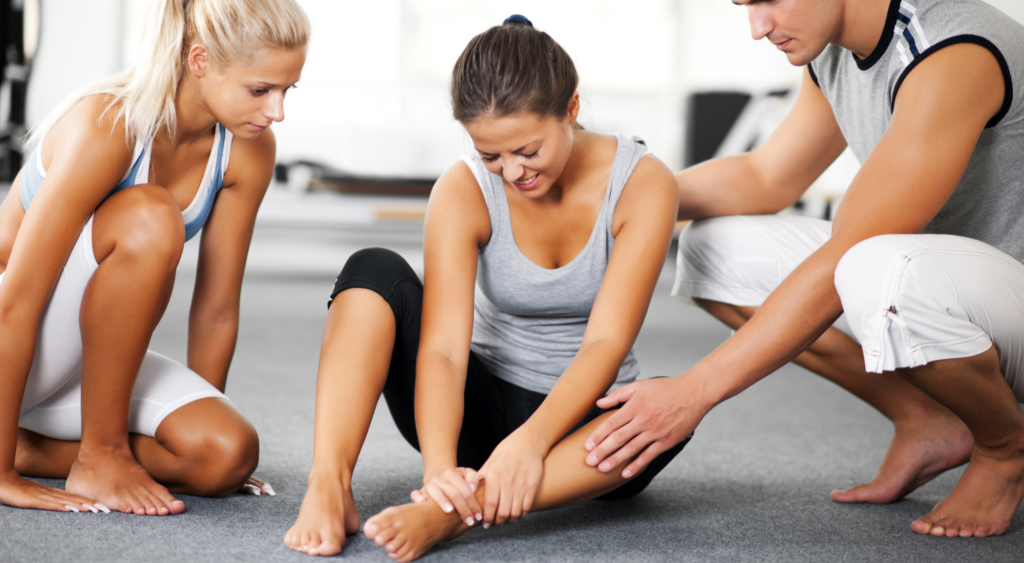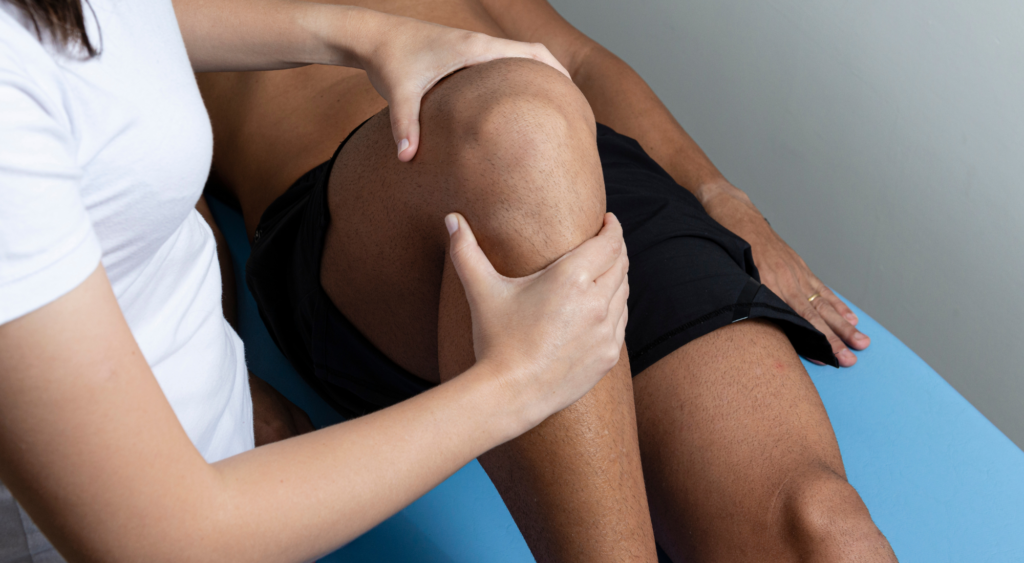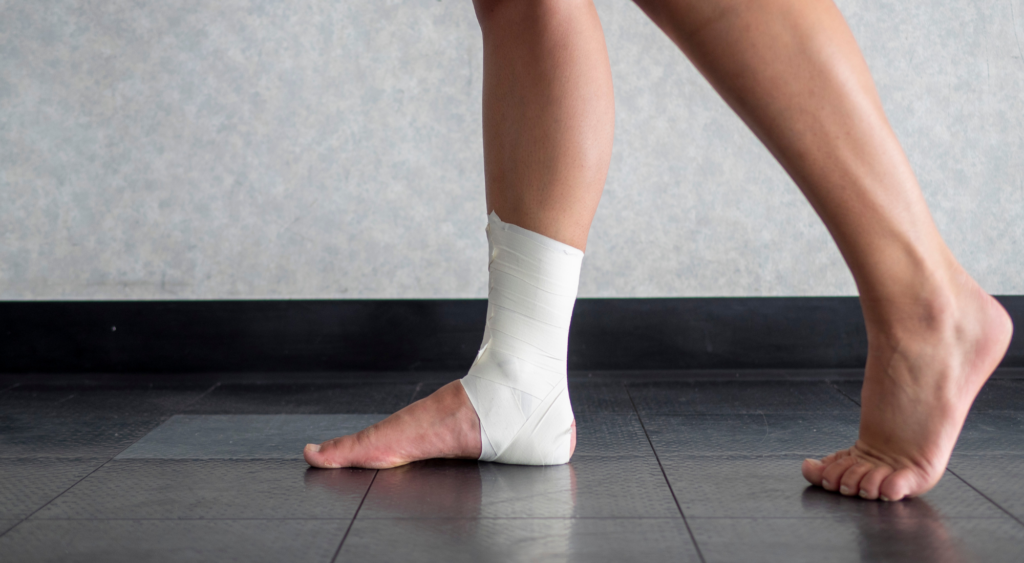You’ve properly warmed up, you know your choreography, and you’re in tune with your body. What are the chances you’ll suffer from a dance injury on the big stage?
Actually, pretty high.
The high level of athleticism, frequency and duration of training and not scheduling enough recovery time can make dancers susceptible to injuries.
Injuries can happen outside the studio or stage as well, due to cross training activities or uncoordinated movements. Maybe you’ve stepped off the curb wrong leaving rehearsal and twisted your ankle, or you run for cross training and are experiencing shin splints.
Whether on or off the stage, injuries for dancers happen.
Learn about the most common dance injuries, how to prevent them, what treatment may look like, and more.
Table of Contents
- 5 Common Dance Injuries
- The Importance of Being Prepared for Dance Injuries
- 3 Ways To Prevent Dance Injuries
- When To See a Doctor for Dance Injuries
- What Type of Practitioner Should You See for Dance Injuries?
- What Does Treatment for Dance Injuries Look Like?
- Dance Wire: Providing Support to the Portland Dance Community

5 Common Dance Injuries
As a dancer, experiencing an injury is rather common.
A 2017 study by the National Library of Medicine found that 86% of full-time, pre-professional dancers sustain one or more injuries in one year.
It could be argued that dancers consistently sustain more injuries than any other athlete or sport. Why might that be the case?
Typically, the training workload is to blame for the number of injuries that dancers experience. It is common for dancers to spend about 20 hours per week dancing between training, rehearsals, and shows. If you compare that to another sports athlete who spends around 2 hours in a practice or game five times a week, that’s a total of 10 hours — half the time that dancers spend training.
It’s no surprise that rest and recovery are to be emphasized to prevent dance injuries.
#1: Sprained Ankle
Ankle sprains are the number one traumatic injury in dancers — they happen unexpectedly from twisting or overstretching the foot.
Sprained ankles most often occur in dancers from:
- An improper landing from a jump
- Strength imbalances in the leg
- Poorly fitted shoes
But they can happen outside of the dance studio, too.
It is important to properly manage ankle sprains because previous injury can be predictive of future injury.
To help a sprained ankle heal, active range of motion like tracing the letters of the alphabet with your foot, compression, elevation, sleep, hydration and nutrient dense food can be helpful in addition to having it evaluated by a dance medicine professional like a physical therapist or chiropractor who can provide specific tailored care for your injury.
#2: Trigger Toe
Flexor Hallucis Longus Tenosynovitis, or “Trigger Toe”, is an overuse injury that causes inflammation and damage to the muscle that is active during the pointing of the big toe.
For dancers, it may feel like your toe is stuck in position while it’s pointed.
To help prevent trigger toe, practice your toe point with good form working from the ankle — avoid crunching your toe to achieve a point. You can practice and increase ankle range of motion working with a theraband, stretching the front part of your ankle and rolling out the arch of your foot with a ball to help achieve good form.
If you do experience trigger toe, having it evaluated by a dance medicine professional like a physical therapist or chiropractor who can provide specific tailored care for your injury can help you through the acute phase and help you improve your technique for prevention.
#3: Achilles Tendonitis
Your Achilles tendon is active often during relevé and pointing of the foot, it is a very strong and resilient tendon but repetitive stress or sudden increase in training can cause Achilles tendonitis.
The irritation of the tendon in the back of the ankle can be caused due to various factors like compression or friction of shoes, sudden increase in jumping or changes in technique or dance style.
To help prevent an injury to the Achilles, it is important to have a good warm-up especially before any jumping or heel work. If you begin to experience pain around the upper part of the heel, have the area evaluated by a dance medicine professional like a physical therapist or chiropractor to determine the reason for the irritation and strategies for management.
#4: Shin Splints
Shin splints can often be a “too much, too soon” type of injury, and can often happen when returning to dance from a break or if there is a change in frequency, intensity or duration of activities. Sudden changes like running, jumping, heel work or dancing barefoot if you have not been used to that can be contributing factors. Bunions, decreased control of the medial arch and uncoordinated landing mechanics can also contribute to the development of shin splints.
Shin splints can happen on the front or back side of the tibia, the shin bone, at the points of attachment along the shaft. Shin splints can occur, and are characterized by sharp increased pain as intensity of activity goes up.
Many factors can influence the experience of shin splints and dancers often have to manage this injury at the beginning of a season or with new styles/techniques. So it is especially important to be evaluated by a dance medicine professional like a physical therapist or chiropractor to help manage the healing while needing to remain active.
#5: Patellofemoral Pain Syndrome
Patellofemoral Pain Syndrome occurs when the patella “kneecap” is compressed against the cartilage of the femur behind it like when sitting for a long time, jumping, plie, kneeling etc.
Dancers can often experience this injury from performing jumps or plies without proper form, not having enough recovery time between ballistic training, or a combination of increased sitting with knees in various amounts of flexion after training, creating pain in the front of the knee.
Being evaluated by a dance medicine professional like a physical therapist or chiropractor can help identify the cause of the pain, and strategies for decreasing pain during the implementation of a treatment plan for healing.

The Importance of Being Prepared for Dance Injuries
Dance injuries are common — more than 80% of dancers injure themselves at least once throughout a dance year — so it’s important to be prepared for when the day inevitably arrives.
Regularly visiting a dance medicine professional like a physical therapist or chiropractor is a great way to prepare — or hopefully, prevent — your body from dance injuries. A dance medicine professional can help identify and create a strategy to address possible risk factors for injury offering a tailored plan that may include a combination of active range of motion, nerve flossing, proprioception training, stabilization and strengthening tailored to your needs. An added benefit is already having an established relationship with a trusted professional if you should need care for an injury.
It can be difficult and frustrating to be searching for reliable care when you’re in pain, your mind is clouded, and you want to get back to dancing as quickly as possible. Having a care team already in place helps eliminate the chance of choosing care providers inexperienced in dance medicine, out of desperation for returning to your activities.
Your care team can consist of sports psychologists, massage therapists, nutritionists, athletic trainers, personal trainers, dermatologists, pilates or yoga instructors etc. Take your time building the care team that helps you address your needs.
Having all of this already in place is a great way to be prepared for dance injuries, and Dance Wire can help you establish these connections if you don’t already have them in place.
Dance Wire — a non-profit organization — is a great hub and resource for the dance community in Portland. No matter what it is you may be looking for, Dance Wire can help you find it.
3 Ways To Prevent Dance Injuries
#1: Get Adequate Sleep
Sleep and recovery go hand-in-hand. Not only does sleep help reduce stress and improve mood — both of which are crucial to the recovery process — but when your body is resting, it can work on fully healing.
When we sleep, our bodies reduce levels of cortisol, the stress hormone. By lowering cortisol, we allow growth hormones to be released, effectively rebuilding injured tissue.
Growth hormones are released during the ‘deep sleep’ phase of our sleep cycles, which happens about every 90 minutes. If you’re getting adequate sleep while recovering from an injury, you’re allowing your body many opportunities for the growth hormones to release and promote healing.
#2: Focus on Quality Nutrition
Proper fuel and hydration are important for both avoiding repetitive stress injuries and helping to heal from dance injuries.
We know the release of growth hormones helps promote healing, but nutrition is important to back up the growth hormone. As growth hormones are released, they look for nutrients in the body to help with the repair process.
Eating a wide variety of delicious nutrient rich foods will provide your body with energy for dancing, and the nutrients required to increase strength, support healing and maintain nutrient stores.
If you are looking for inspiration to increase the variety of foods you can eat, try some of these options:
- Fruits
- Grapes
- Pomegranate
- Berries
- Apples
- Berries
- Melons
- Mango
- Peaches
- Grapefruit
- Apricots
- Vegetables
- Carrots
- Bell peppers
- Cauliflower
- Broccoli
- Brussel sprouts
- Sweet potatoes
- Cabbage
- Potatoes
- Anti-inflamatory fats
- Fish
- Nuts
- Oils
- Seeds
- Dark leafy greens
- Kale
- Bok choy
- Spinach
- Swiss chard
- Romaine lettuce
- Mustard greens
- Proteins
- Chicken
- Seafood
- Eggs
- Tofu
- Nuts
- Beans
- Lentils
- Probiotics
- Yogurt
- Kimchi
- Sauerkraut
- Kefir
- Whole grains
- Steel-cut oats
- Quinoa
- Rice
- Whole wheat bread
#3: Don’t Skip Your Warm-Up
Preparation is key, which is why taking the time to properly warm-up is crucial to helping prevent dance injuries.
A warm-up will incorporate movements that flow from singular to multiple joint movements, increase blood flow bringing nutrients and oxygen to the areas you will be using most in your dance style, bring you into a more grounded and mindful state from which to move from, move you through proper technique for your dance form, and get you ready for more complex movement patterns.
Mimicking the warm-ups you have been taught by your trusted teachers and incorporating elements that have been given to you by a dance medicine professional specific to your needs can be a great way to start building a personalized warm-up sequence that addresses your dance style and personal needs.

When To See a Doctor for Dance Injuries
Many dancers can become very knowledgeable over time on how to manage minor injuries with the help of dance medicine professionals and their teachers. But there are times when getting the knowledge and support from a dance medicine professional like a physical therapist or chiropractor is helpful and necessary to heal. Your injury may be more severe than you originally thought or you might be dealing with a different injury than you suspected. Here are some reasons to go get it checked out:
If you are experiencing an injury you have never had before
If an injury seems minor but isn’t healing over time
If an injury isn’t responding to your care the way you would expect
If the things you think should make it better, make it worse.
Injuries can affect different tissue types in the body (bone, ligament, joints, muscle, tendon, nerves, fascia, skin, bursa etc), and all those tissue types require different healing strategies. Having professional support throughout the healing process will help get you back to dancing as quickly as possible.
What Type of Practitioner Should You See for Dance Injuries?
Dancers are often hesitant to head to a practitioner following an injury because they’re nervous they’ll be told they need to stop dancing.
Visiting a dance medicine or sports-specific provider — such as an athletic trainer, physical therapist, chiropractor or orthopedist can get you properly diagnosed and following a treatment plan appropriate for your injury that includes understanding the cause and modifications you can make, which will improve your healing time.
A primary care or emergency medicine doctors may be able to assess for trauma like fractures or sprains, but may not have the dance medicine specific knowledge to provide a robust treatment plan. Dance Wire is a great resource for finding dance medicine providers should you experience a dance injury. Refer to our directory for help.
What Does Treatment for Dance Injuries Look Like?
You’ve experienced a dance injury. Now what does your treatment look like?
Often, a dancer who has experienced a dance injury thinks they have to stop moving, wrap the injury, rest, and ice it. The reality is that this is usually not the best treatment plan for a dance injury.
A dance medicine provider will provide a thorough evaluation including a history of your injury, and a physical exam. Then they will be able to share a treatment plan and make recommendations to promote and support your healing. Getting properly diagnosed and treated will reduce the likelihood of a prolonged injury, reduce the likelihood of re-injury as you are trying to return to your normal activities, prevent compensations, and reduce the loss of proprioception, strength and flexibility.
Dance Wire: Providing Support to the Portland Dance Community
Are you a dancer searching for a community that provides resources, knowledge, support, and much more?
Dance Wire in Portland provides dancers access to endless resources in the Portland dance community. Whether you’re searching for a dance studio, dance spaces, or dance-specific doctors, Dance Wire can help you find it.
Our non-profit organization works to be the top hub for the dance community in Portland, helping to connect the entire ecosystem of dance.
Contact us today to find out how we can help.

